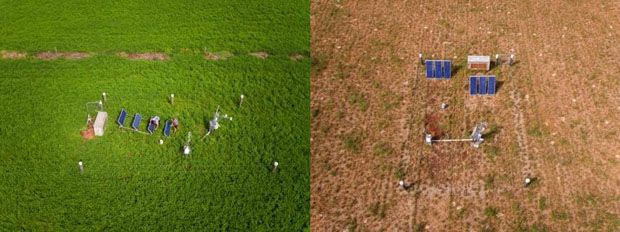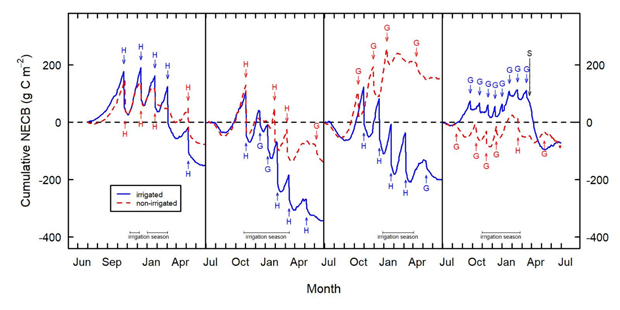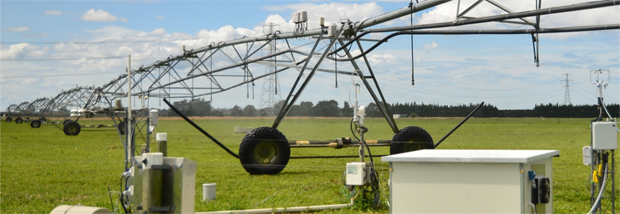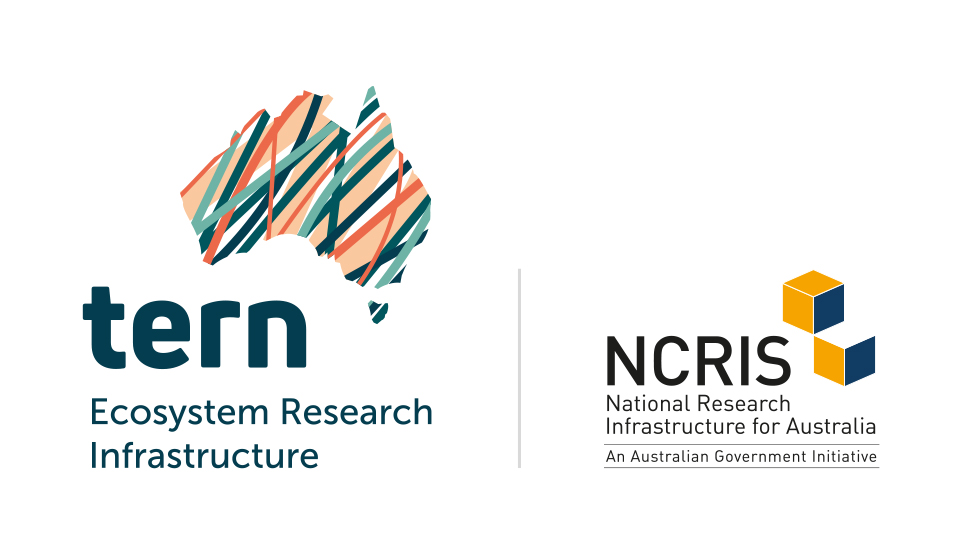
For this month's site feature, let's journey south-east from Australia's red centre, to Te Waipounamu, the South Island of New Zealand. The Ashley Dene OzFlux site is located in one of New Zealand's large dairy regions, on the Canterbury Plains, and its data are essential contributions to research projects on the carbon, water and nitrogen exchange of dairy forage systems. The site is run by a team of researchers from Manaaki Whenua - Landcare Research  , with the responsibility for the site and data operations shared between Johannes Laubach
, with the responsibility for the site and data operations shared between Johannes Laubach  and John Hunt
and John Hunt  .
.
The Ashley Dene OzFlux site was established in 2015 at Lincoln University's Ashley Dene Research and Development Station  , 30 km south-west of the city of Christchurch. This station has been owned by Lincoln University for over 100 years and covers 355 ha of land. It is used for agricultural research and teaching while also run for commercial milk production. The OzFlux site was established while several paddocks on the farm were converted to lucerne (Medicago sativa L.), with some of these covered by a pivot-irrigator system that was established at the same time. To be able to assess the effects of contrasting management approaches on carbon and water budgets, the researchers opted for a paired-site approach, with identical instrumentation set up in irrigated lucerne and, 700 m away, in non-irrigated lucerne. The measurements over lucerne operated continuously for almost five years. In 2020, a new project was started, on the greenhouse-gas budgets of mixed-species pasture, which is described in the final section of this article.
, 30 km south-west of the city of Christchurch. This station has been owned by Lincoln University for over 100 years and covers 355 ha of land. It is used for agricultural research and teaching while also run for commercial milk production. The OzFlux site was established while several paddocks on the farm were converted to lucerne (Medicago sativa L.), with some of these covered by a pivot-irrigator system that was established at the same time. To be able to assess the effects of contrasting management approaches on carbon and water budgets, the researchers opted for a paired-site approach, with identical instrumentation set up in irrigated lucerne and, 700 m away, in non-irrigated lucerne. The measurements over lucerne operated continuously for almost five years. In 2020, a new project was started, on the greenhouse-gas budgets of mixed-species pasture, which is described in the final section of this article.
Aerial view of the flux sites at Ashley Dene in irrigated lucerne (left, credit: Bradley White) and non-irrigated (right, credit: Bradley White) lucerne during a dry summer.
The role of flux towers in monitoring New Zealand's growing and intensifying dairy industry
The intensity and extent of dairy in New Zealand has increased in the past 30 years, with over 800,000 ha of irrigated land supporting the industry. Coupled with this intensification is concern for the impact these land use practices have on soil carbon stores, ecosystem water use, nutrient leaching and net greenhouse gas emissions. In the Canterbury Plains region, where Ashley Dene is located, annual nitrate leaching is estimated to have doubled  between 1990 and 2010 where irrigation of vast areas of the stony alluvial soils poses a risk to both surface and groundwater quality. The role of flux towers in quantifying ecosystem-scale fluxes from these intensively managed agricultural systems will contribute towards improving management practices not only in the Canterbury Plains region, but for the dairy industry in New Zealand and globally.
between 1990 and 2010 where irrigation of vast areas of the stony alluvial soils poses a risk to both surface and groundwater quality. The role of flux towers in quantifying ecosystem-scale fluxes from these intensively managed agricultural systems will contribute towards improving management practices not only in the Canterbury Plains region, but for the dairy industry in New Zealand and globally.
Is lucerne a means of reducing carbon and nitrogen losses from farms?
Lucerne is promoted as an alternative forage crop that can survive extensive summer drought periods, as they are common in the South Island's eastern and central regions. Lucerne was established at Ashley Dene in spring of 2015 and eddy covariance measurements began soon after. One flux tower was installed over irrigated lucerne and another over non-irrigated lucerne to quantify the carbon  and water
and water  budgets of these two managed ecosystems. In addition, large drainage lysimeters were added in 2016 to measure the leaching losses of carbon, nitrogen and phosphorus
budgets of these two managed ecosystems. In addition, large drainage lysimeters were added in 2016 to measure the leaching losses of carbon, nitrogen and phosphorus  from the soils.
from the soils.
'There are very few sites around the world where matter balances of an agricultural system have been measured so comprehensively over several years, including exchange with the air, flows in the soil and exports and imports associated with farm management activities.
For carbon and water balances, we have achieved quantification of all major terms. For nitrogen, we did not have the resources to include gas exchange of the lucerne, but we have recently acquired an instrument enabling us to measure ammonia and nitrous oxide fluxes in future projects.
We are looking forward to having our comprehensive dataset used for the modelling of a variety of management scenarios, which will give further guidance on how to optimise farming practices for reduced environmental impacts.' – Johannes Laubach
Some key messages that resulted from this work include the following:
- Irrigated lucerne had greater biomass production than non-irrigated lucerne, but it also lost more carbon each year.
- - Of note were particularly high carbon losses from the irrigated lucerne following heavy rain events in a wet summer. This suggests that water-saving approaches such as "smart irrigation" and "deficit irrigation" are potentially beneficial for soil carbon balances, too.
- Irrigated lucerne lost much more nitrogen through leaching compared to non-irrigated lucerne, indicating no environmental benefits from growing irrigated lucerne. The high nitrogen leaching rates were largely driven by high nitrogen inputs from repeated effluent application with the irrigator.
- Both irrigated and non-irrigated lucerne were originally managed in cut-and-carry operation, and in later years switched to being grazed. Grazing reduced the ecosystem carbon losses for the irrigated lucerne and avoided them altogether for the non-irrigated, which is due in part to the carbon returned in dung and in part to a reduction of the amounts of biomass removed.
- However, grazing of the non-irrigated lucerne increased nitrogen leaching, due to the added inputs from cow excreta, so there was a trade-off between desirable outcomes for carbon and nitrogen budgets.
- Land conversion, both into and out of lucerne, resulted in the biggest losses of carbon. This strongly suggests farmers should aim to keep bare-soil periods as short as possible if seeking to maintain ecosystem carbon stores.
Annual cumulative net ecosystem carbon balance (NECB) of irrigated and non-irrigated lucerne at the Ashley Dene OzFlux site, from July 2016 to June 2020, restarted from zero every July 1st. NECB includes the net exchange of carbon dioxide, biomass export from harvest and grazing, inputs from effluent and dung, and leaching of dissolved carbon. Grazing (G) and harvest (H) events are marked on the figure, as is the herbicide spraying (S) to kill the irrigated lucerne and begin conversion to mixed-species pasture. NECB values above 0 represent net carbon gains of the system and NECB values below 0 represent net carbon losses (After Laubach et al 2019  , modified to include more recent data).
, modified to include more recent data).
Exciting activities on the horizon for the Ashley Dene OzFlux site
In 2020 the Ashley Dene OzFlux site transitioned to a new research project, aiming to find out whether pasture composed of purposely selected multiple species can have reduced net greenhouse gas emissions, compared to conventional ryegrass-clover pasture. During April – while New Zealand was in lockdown because of the COVID-19 pandemic – the irrigated lucerne was converted to pasture, in the northern half of the area with a mix of five species and in the southern half with ryegrass and white clover only. Fortunately, the researchers had already managed to upgrade the existing eddy covariance site in January 2020, with the installation of a multi-gas analyser (dual-laser spectrometer) capable of measuring carbon dioxide, methane, nitrous oxide, water vapour, ozone and ammonia simultaneously, in order to obtain direct, time-resolved, measurements of the pasture-atmosphere exchange of all major greenhouse gases. While COVID-19 forced the researchers to work from home through the conversion and establishment period of the new pasture, they could watch the new instrumentation operate flawlessly, side-by-side with the original one (for carbon dioxide and water vapour fluxes).
In August 2020, measurements were discontinued at the non-irrigated lucerne and the instrumentation moved into the irrigated ryegrass-clover pasture. This reinstates a paired-site approach for recording the carbon dioxide and water vapour fluxes of the two pasture types, while for the other gases the researchers rely on a split-footprint approach  applied to the data from the multi-gas analyser system.
applied to the data from the multi-gas analyser system.
One of the five species in the mixed pasture is plantain (Plantago lanceolata L.) which, by mechanisms not fully disentangled yet, has elsewhere shown promise to reduce nitrous oxide emissions from the pasture soil. Key aims of this research are to confirm such a reduction at the paddock scale and to assess whether mixed-species pasture enhances the carbon balance over ryegrass-clover pasture (which would be a co-benefit) or reduces it (which would be a trade-off). A similar experimental setup exists at the Troughton Farm site  , operated by the University of Waikato, where dairy farming relies on natural rainfall year-round.
, operated by the University of Waikato, where dairy farming relies on natural rainfall year-round.
Johannes is excited that these aligned projects will further the collaboration of the two groups of researchers, working at the cutting edge of micrometeorological applications (with the split-footprint approach) while also aiming for impact from obtaining results that will allow sound advice whether mixed-species pastures offer net benefits to reduce greenhouse gas emissions.
Irrigator and research equipment at the Ashley Dene OzFlux site in early 2020: the new eddy-covariance system on the right, with multi-gas analyser in the white box (front of picture), the original eddy-covariance system in the centre, and ancillary weather-station instruments on the left (credit: John Hunt).





